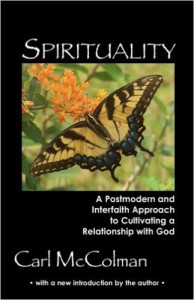 Okay: to summarize…
Okay: to summarize…
Spirituality: the process of being in relationship with God.
Belief and Wonder: the mental and emotional qualities of being open to the possibility of Divine presence in our lives.
Culture, Ikons, Teachings/Tradition/Scripture: the stuff in our lives that carry the news of God to us; the evidence we have of God’s presence and the clues we have to help us recognize God’s presence in our own experience…
Community: the people who are our spiritual family, who support us in our opening-up to God and who help us to recognize the presence of God in nature and in culture and in ourselves.
Any questions?
Next… what is the process of forming a relationship with God? If you want to get in shape, you exercise; if you want to lose weight, you diet; if you want to get organized, you set up a filing system. So what to you do to forge a more intimate relationship with God?
Answer: you pray.
PRAYER — from the Latin word for “begging,” “requesting a favor” — arises out of a theology that focuses on the human/divine relationship in a way that stresses Divine generosity and Human neediness. Read: Matthew 7:7-11
The Christian mystical tradition, beginning with Jesus who dared to call God “Abba” — the Aramaic equivalent of “Daddy” — has boldly added a new dimension to prayer: beyond the mere transactional quality of begging or asking for favors. Christian spirituality brings a new sense of prayer as cultivating a relationship. The words “Meditation” and “Contemplation” and “Adoration,” each of which signifies a kind of prayer, illustrate this development of intimacy replacing bargaining as the central fact of prayer.
Four Requirements for prayer:
- Belief. Openness to the idea that God is interested in a closer relationship; remember, belief is not the same as the absence of doubt! It is simply a willingness to be open, a willingness to doubt your doubts, as it were.
- Discernment. Ability to identify evidence of God’s presence in your life. This requires familiarity with tradition and, almost always, involvement in a community — relationship with others who are engaged in the process of prayer and discernment, also.
- Technique. A method of prayer, a set of rules and procedures for getting down to it. It’s like a mating ritual.
- Proper setting. Just as you need a proper setting for mating rituals, well, you also need a proper setting for fostering greater intimacy with God.
Belief we’ve already covered; discernment I’m going to hold off on until we look at community more closely over the next two weeks. For now, let’s look at setting and technique.
SETTING: Prayer may happen at any time and at any place. However, some settings are naturally conducive to prayer. These include:
— personal times of silence and solitude;
— intimate settings, such as spiritual direction, pastoral counseling, or family time together;
— communal settings, best exemplified by the church community gathered in prayer;
— any situation where the opportunity exists to take a stand for God’s healing and reconciling presence in the world.
TECHNIQUE: Basically, prayer falls under two broad categories:
— DISCLOSING one’s self to God; “Saying one’s prayers” … can be formal or informal, recited or extemporaneous, and usually involves adoration, confession, intercession, petition, and thanksgiving;
— LISTENING for God’s disclosure to ourselves. Etymology of Contemplation: from Latin, con-templare, literally “with time” Listening prayer is the prayer of time spent with God.
Etymology of:
Contemplation — from the Latin, literally meaning “waiting for a sign” — I make a mistake in my book! Not “with time” but “within the temple where auguries were cast” … although it was not a horrible mistake, for the meaning of the word has a clear sense of waiting and expectancy. It’s a word implying openness, openness to awaiting the word of God. In Pagan times, this meant the augury, in a Christian context it simply means being open and waiting for the word of God which may come to us in any way, according to God’s will.
Meditation — from the Greek medesthai, to be mindful, to be thoughtful, or to plan. A different connotation than contemplation, for it implies a more active engagement with the object of meditation, whether that be scripture, or an icon, or whatever. Interestingly, with the arrival of Zen and other forms of spiritual discipline from the East, “Meditation” has taken on the connotation of “Eastern mental spiritual discipline” — however, disciplines such as Zen have more in common with contemplation than with meditation! The classic meaning of meditation would probably be best captured today in the concept of “theological reflection” — which is in itself a lovely image, for it suggests that we capture, and then reflect like a mirror, the radiance that emanates from God.
Adoration — if contemplation is a passive aspect of prayer, and meditation is a reflective aspect of prayer, then adoration is a fine example of a more active aspect of prayer. From the Latin ad- + orare, originally meaning to speak formally to, but in later Latin carrying the connotation to worship. With the connotation of worship came the sense of love or devotion, today, we can best see in this word a sense of worshipful speaking (or thinking) addressed to the Divine. In contemplation we listen for God’s word, in meditation, we reflect on God’s word, and in adoration, we speak to God.
This is different from the prayer of beseeching, which is petition. Nothing wrong with petition, but since this is a class on spirituality, and spirituality is about relationship with God,, that is not the form of prayer that I wish to emphasize! This is not the prayer of asking God for favors, or of confessing our failings to God, or of asking God to help others. Those are the prayers of petition, confession, and intercession. Adoration is simply the prayer of expressing intimacy with God, or sharing with God who we are and opening up our desire to be closer to God, to God. It’s a prayer of nakedness and vulnerability.

If enough time at end: offer four circles diagram.
“Prayer is not just a solitary activity, nor is it just a community-based activity. Indeed, prayer is the core element of spirituality, for it is the activity common to both solitary and communal expressions of the Christian life.”

This blog post consists of notes from a class on prayer that I taught probably in 1997, most likely at the Episcopal Church I attended at the time.
These notes include concepts from my first book, Spirituality, published in May 1997.
I was cleaning out my file cabinet recently and found a hard copy of these notes; I don’t have them saved anywhere, and wanted to convert them to electronic form — so I figured why not put them on my blog. I’m missing at least one page of the notes, since they begin with a summary (but I don’t have a page with the material being summarized!).
With the exception of correcting a misspelled word and inserting a missing word, I’m presenting the notes here exactly as they were typed and printed out back in the ’90s.
Incidentally, the first time I mention the etymology of contemplation (under “Technique”), it is incorrect. Notice that I correct myself in the “Etymology” section, and mention that “I made a mistake in my book!” — the book in question being Spirituality.
The “four circles diagram” illustrated the relationship between solitary prayer, spiritual direction, faith community, and service to the world: those four dimensions of spirituality existed in the diagram as four concentric circles: my contention was that the larger circles supported/gave purpose to the inner circles, while the inner circles provided spiritual sustenance to support the relationships found in the outer circles. Learn more about it here.
My apologies for the “non-linear” character of today’s post. It was fun for me to be reminded of my thoughts as I taught a class so long ago; I hope you find some of this material useful as well.
Enjoy reading this blog?
Click here to become a patron.
Butterfly photograph by Fran McColman.














